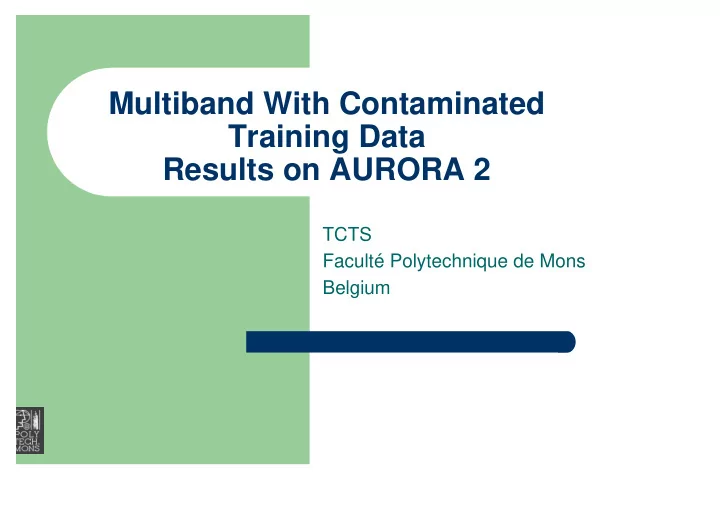

Multiband With Contaminated Training Data Results on AURORA 2 TCTS Faculté Polytechnique de Mons Belgium
INTRODUCTION •The noise contamination of speech corpus leads to quasi− optimal performance when test noise conditions match training noise condition. •We observe that, in narrow frequency bands, the noise characteristics basically differ by their level only. •Combining the multiband approach and the training data contamination can lead to models robust models for any kind of noises. •We train models in each subband from data corrupted by white noise at different SNR. Subbands are then recombined using a MLP.
CONTAMINATED TRAINING CORPUS Adding white noise SNR = 0 dB Adding white noise SNR = 5 dB Adding white noise Sampled Noisy speech SNR = 10 dB speech corpus corpus Adding white noise SNR = 15 dB Adding white noise SNR = 20 dB
MULTIBAND ANALYSIS Grouping and ANN normalization Noise suppression methods Bandpass analysis 0−376 Hz Compensation methods Bandpass analysis 307−638 Hz Bandpass analysis 553−971 Hz Filter bank Windowing analysis Bandpass analysis 861−1413 Hz Bandpass analysis 1266−2013 Hz Microphone arrays Bandpass analysis 2213−2839 Hz Noise robust acoustic features Bandpass analysis 2562−4000 Hz
NONLINEAR DISCRIMINANT ANALYSIS NLDA parameters State posteriors probabilities Acoustic features
ROBUST ASR Automatic speech Concatenation recognition system Robust parameters Training on Model contaminated data adaptation
AURORA 2 Clean training set: 8440 utterances Multi−condition training set: 8440 utterances Contaminated training set: 8440 utterances corrupted by white noise + 4220 clean utterances. Test set ‘a’: 4 different kinds of noises matching the multi−condition training set covering SNR from clean speech to –5 dB. Acoustic models: Hybrid HMM/MLP trained on Daimler−Chrysler word models (127 HMM states). Recognition: STRUT Viterbi decoder, no syntax
TEST CONDITIONS Clean training set/J−RASTA MLP: (15*13) x 1000 x 127 = 323,195 parameters Multi−condition training set/J−RASTA MLP: (15*13) x 1000 x 127 = 323,195 parameters Contaminated training set/multiband –7 subbands (15*4) x 1000 x 30 x 127 Recombination MLP: (3*210) x 1000 x 127 Total: 1,531,185 parameters –7 subbands (15*4) x 150 x 30 x 127 Recombination MLP: 210 x 500 x 127 Total: 285,565 parameters
RESULTS Number of Number of Number of parameters parameters parameters 323,195 323,195 323,195 323,195 1,531,185 323,195 323,195 285,565 1,531,185
CONCLUSIONS The combination of the multiband paradigm and training data contamination has been tested on the reference task: AURORA 2. We got up to 57% relative improvement compared to robust features such as J−RASTA PLP features. Compared to matching noise condition training, WER are only 10% (relative) higher. Test with a very « light » system led to a small degradation of recognition performance.
Recommend
More recommend